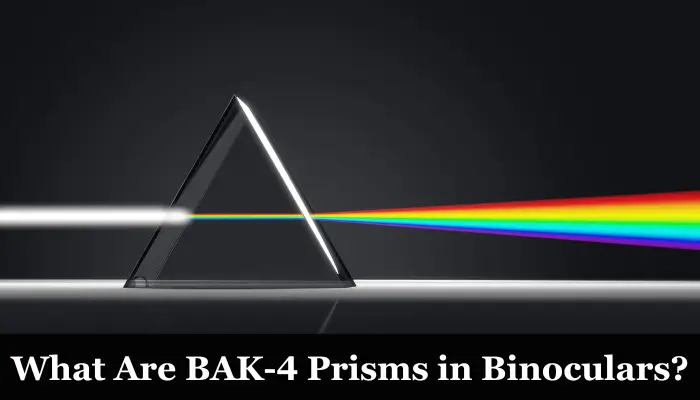This post may contain affiliate links which means I may receive a small commission for purchases made through the links. Learn More
As you know, all the binoculars need a prism for their functionality. Different types of prisms are available in the market which are used in binoculars. But one of those prisms is the BAK-4 prism which is very famous among the high-end binos.
But the question is what is BAK-4 prism and why is it so famous? This is going to be our topic. I will explain everything about the BAK-4 prism and let you know whether you should choose the binoculars with the BAK-4 prism or not.
Related Article: Why Are Prisms Preferred Over Mirrors in Binos?
What is BAK4 Prism in Binoculars?
BAK-4 prism is actually a type of Porro prism that is used in the binoculars to reorient or correct the image. BAK stands for Barium Krownate. This prism is pretty special because it is made with high-density glass which has a refractive index of 1.56.
In the past, the technology was limited, and the manufacturers used to use simple porro or roof prism in the binoculars. However, things have changed now – and manufacturers use different types of prisms to get visual quality from the binoculars.
The BAK-4 prism is special because it is made with high-density glass so it transmits all the light that the objective lens sends to it. There is no loss of light, making the visuals clearer and sharper from the edges,, especially in the lowlight conditions.
Working of BAK-4 Prism in Binoculars
BAK-4 prism works very similarly to other types of prism that are usually used in binoculars. But due to its greater refractive index of 1.568, it refracts more efficiently, and there happens no loss of light and the maximum light goes to the eyepiece.
Let me explain in detail. First of all, objective lenses capture the light, and send it to the prism. If there is a normal prism used, then some amount of light gets lost due to the inefficiency of the prism used to correct the orientation of the image.
But when the manufacturer uses the BAK-4 prism which is made from high-density glass material, then it does not waste any amount of light. Instead, it reflects all the light, and ensures that the maximum light goes to the eyepiece which magnifies the visuals, and then sends it to the user.
The role of the BAK-4 prism is to maximize the reflection of light and ensure that there is minimal loss of light. More light refraction means that there will be maximum light transmission from the prism to the eyepiece where the lenses magnify the light (image) and the user sees bigger visuals through the eyepiece of the binoculars.
Also Read: What Are Porro Prism Binoculars?
Advantages of Using BAK-4 Prism in Binoculars
This is an important section of this article as it will help you understand why the manufacturer prefers to use the BAK-4 prism when they manufacture high-end or premium binoculars. Let’s dive down and learn about the benefits of using BAK-4 prisms in binos.
1- Better Light Transmission
First of all, the BAK-4 prism is made with high-density glass material which increases the refraction of light and ensures better transmission of light. What amount of light comes to the prism, and the same amount of light goes from the prism to the eyepiece?
It means there is a very negligible amount of light that gets loose during the reflection process by prisms. As more light goes to the eyepiece, then the user also gets brighter, and sharper visuals without any issue at all. It increases the overall quality.
2- Edge to Edge Clarity
The BAK-4 prism is made with high-density glass which has a higher refractive index, it bends all the light towards the eyepiece. It does not support the distortion or divergence of the light which goes towards the eyepiece from the prism.
Due to efficient bending of light, the better and clearer visuals go to the eyepiece where lenses magnify those visuals and send them to the users. The exit is usually round which helps in providing the user with edge-to-edge clearer and shaper visuals.
3- Improve Lowlight Usability
The performance of the binoculars in the lowlight gets better when the manufacturers use the BAK-4 prism in the binoculars. Actually, in low light conditions, the objective lens captures less light from the surroundings. In usual cases, the loss of light happens during the orientation correction of the image by the prism and it affects the visual quality.
But when the manufacturer uses the BAK-4 prism, then there happens no loss of light. Thanks to better high-density glass material, and high refractive index of the BAK-4 prism. So, the maximum light goes from the prism to the eyepiece and you end up seeing a brighter image in the lowlight conditions.
In binoculars that do not feature BAK-4 prisms, there is a loss of light during the working of the prism. You can afford to lose the light, especially in lowlight conditions when the objective lens is already capturing less amount of light. It affects the visual quality badly.
Also Read: What Are Roof Prism Binoculars?
Drawbacks of Using BAK-4 Prism in Binoculars
In the section above, I have explained the benefits and why the manufacturers use the BAK-4 prism in their high-end binoculars to ensure that the users get perfect visual quality. But there are a few cons associated with the BAK-4 prism which I am going to discuss in the section below.
1- Cost of Prism
One of the most important and biggest drawbacks that the manufacturers face is the price of the BAK-4 prism. In fact, you won’t get BAK-4 prisms in budget-friendly binoculars because the manufacturers try to cut the price of binoculars by using some other kind of prism such as the BAK-7 instead of the expensive BAK-4 prism.
If you want to use binoculars with a BAK-4 prism, then you must have a handsome budget. You won’t get a BAK-4 prism in binoculars under $100 binos. Keep in mind that the binos which come with BAK-4 prisms offer ideal optical performance both in daylight and low-light conditions. Such binos deserve additional bucks.
2- Weight of Binoculars
The BAK-4 prism is made of glass which has a higher density. So these prisms are heavier than the ordinary prism. This weight adds up to the overall weight of the binoculars which is another issue. This is bad news for those people who love lightweight pairs.
One thing that I must mention is that the BAK-4 prism does add too much weight to the binoculars. I have used the BAK-4 prism binoculars many times and they feel OKAY regarding weight. If you are addicted to using super lightweight pairs, it can be an issue for you.
Honest Verdict – Does BAK-4 Prism Binoculars Worth it?
To be honest, Yes, the BAK-4 prism binoculars are worth the investment because they actually provide you with images free of color distortion. You will get perfect edge-to-edge clarity in the visuals. I am in favor of the BAK-4 prism in binoculars.
Look, why do you use binoculars? Obviously, because you want to see a clear image of distant objects. Right? But does it make sense to buy binoculars that do not give clear visuals without any sort of distortion? Certainly, it does not make sense.
Although the BAK-4 prism binoculars are slightly more expensive, they ensure that you will get ideal visuals with edge-to-edge clarity. Spending slightly more than regretting buying average binoculars is better.
How can I overlook the performance of BAK-4 prism binoculars in lowlight conditions? They are just fantastic in low-light environments such as cloudy weather or before dawn or after dusk. They enhance the light transmission which ensures that you will get brighter visuals in the lowlight conditions.
The average or general binoculars do not give edge-to-edge clarity, plus their performance in lowlight conditions is also questionable. This is why I 100% suggest you go for BAK-4 prism binoculars and get perfect views from a distance.
Conclusion
BAK4 prism has become a part of almost all high-end binoculars. They are getting even more popular because they offer excellent visual quality even in low-light conditions. If you are still confused, I would suggest you go with the BAK-4 prism, and you won’t regret it at all.
However, you should also look at your budget, because I don’t want you to put an unnecessary burden on your bank. With the hopes that this article would bring some new information to you, I am going to stop. See you with another helpful guide.

I’m a passionate outdoor activist who has got special love for optics. The school studies in optical mechanics and the travelling experience has made me an expert in optics like binoculars, scopes, and other devices. Stay connected with us for in-depth knowledge!

